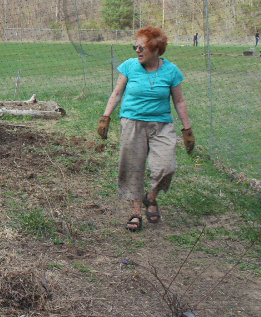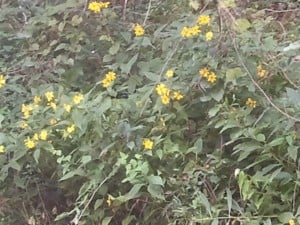-Daphne Gooding
Big Ugly was a farming/gardening area in the past. The main cash crop was tobacco. Tobacco has not been grown for about thirty years. If you know anything about tobacco and farming techniques used thirty years ago, you know 1. Tobacco is very demanding of the soil, and 2. Cultivation techniques used in the past robbed the organic material from the soil and employed chemicals, especially pesticides, with long half-lives. What that means is that the natural balance of the soil was destroyed. Remember DDT? We are still trying to overcome the effects of its use. Other chemicals with long lifetimes were just as bad, but didn’t have a book like Silent Spring to spread the word. Just as in the human immune system where a healthy balance of organisms is important, the soil and the plants that grow need a healthy balance. The competition between pests and pathogens is what keeps overgrowth in check. Additionally, since most pests and pathogens have a very short regeneration time, resistance to substances like pesticides can be acquired fairly rapidly in the absence of natural enemies.
What that meant for me this year was really evident in the new garden I started. I have a 15 X 20 ft garden beside my house and a few raised beds scattered around. This year I wanted to bring a former tobacco plot back into cultivation. It is across Big Ugly Creek from the house and up against the edge of the hill. Tobacco has not been grown there for 30 years. Some large animals have used it for pasture. I ran my horses on it last year, and since the soil is a sandy loam (more sand than loam), I thought it might do well for some of the root crops. There would also be enough room for successive plantings of corn and beans.
I have always liked the idea of a kitchen garden and a staples garden. The kitchen garden is near the house and you can go out and get a bit of this or that for dinner, but there is not too much of any one thing. The staples garden is where all the produce for storing is grown. This year, bringing that piece across the creek into cultivation would allow me to have a staples garden. I had even hoped to get some of our teens interested in the garden so they could sell produce at the Farmer’s Market or to other outlets. West Virginia has an amazing Farm to School program that encourages schools to purchase locally grown items to use in their feeding programs.
The new piece of land was too large to use my normal preparation techniques. I love Lasagna Gardening, and use the methods I learned from that book as much as possible. Those methods help to restore the balance about as quickly as possible. But this new piece of land was too large. It was overgrown with some kind of wild Helianthus (Jerusalem artichoke) that could not be used for food because the tubers were woody. I sowed winter rye in the fall, but the deer ate most of it. Deer don’t eat the rye grass, but they do eat the grain before it sprouts. Anyway, I am still digging up those roots. And the bugs! I have never had that many Colorado potato bugs, Mexican bean beetles, flea beetles and goodness knows what else. There was no balance and those pests simply destroyed the potatoes, beans, eggplants, and other stuff. What to do?





We’ve had the same problem with the bugs! Spinosad has helped a lot. Trouble is with weather and time available it doesn’t always get done.